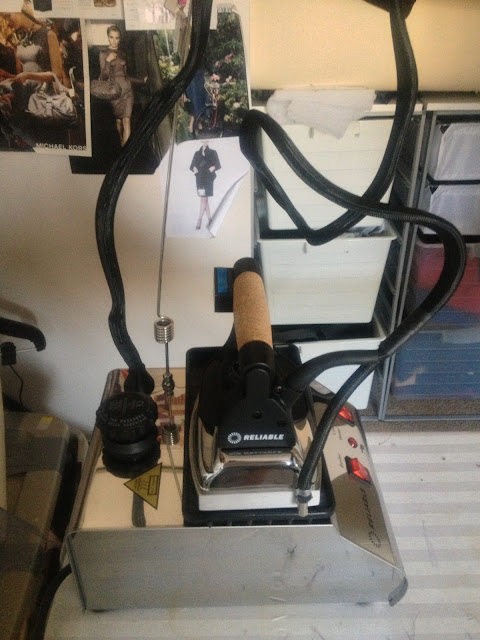In my mind's eye on Monday night I saw a chambray (leftover fabric from my Valentine's dress) button-down blouse with a tie collar and a sequin tank top to wear over it, either in pink or gold. I guess what triggered this creative thought were all the sequin tank tops under blazers that girls wear in Pinterest Pins. I guess I felt left out.
I started on the pattern the other night. I based the pattern for this blouse on the bodice pattern from this dress (also my valentine dress), mostly because it fits so well over my bust.
To adopt the pattern, I started by tracing the pattern pieces, and extended the side seams, center front, princess seams, and center back so that the pattern extends past my natural waist like a normal blouse, which would look best hitting just above my hips.
**You may be wondering why I have a full center front piece for this pattern, and not just a half pattern piece that is placed on a fold when cut out.. it's because my body is asymmetrical, so my right side is different from my left. For this blouse I have all different pattern pieces for both sides**
I made the hem at center front longer than at the princess seams because I want them hem to be like a traditional button up blouse, with the front and back longer than the sides.
I then traced my side pieces and extended the princess seams and side seams to correspond to the center front piece. I did the same thing for my back and side back pieces as well.
I then used my Vary Form Curve (or can be called a French Curve in some settings) to blend the hem from the side front pieces to the center front piece, to make a nice curved hem.
I did this whole process, with the same measurements, for my back pieces as well.
Once the patterns were all adjusted, I cut them out. Please note that I NEVER add seam allowances to my paper patterns anymore. I've learned from my classes at SLCC Fashion Institute that it is best to add seam allowances only when the pattern is cut. This makes the whole process of altering patterns during fittings much, much easier. Obviously, this only works when making patterns for individuals. In the industry when computer patterns are made and are cut by another person for production, seam allowances are added to those patterns for accuracy.
When cutting out, I have to true my darts to make sure that the seam lines are accurate when sewing. To do this, I folded the pattern at the dart point.
I then folded the dart as it would be sewn. I then cut along the seam line with the dart still folded over.
When the dart is opened, the seam line is perfectly trued:
The next step is to make sure that all the seam lines match up (this necessary process proves why not having seam allowances is so nice when making patterns). I did this on the front pieces by carefully guiding the side front panel's seamline (the cut edge of the pattern) down the center front panel's seamline. this is tricky to do when my seam lines are so curved, which is why it has to be done carefully, and probably a few times. I also had to make sure my darts were folded as they are sewn since they take out excess in the seam line.
On some of my pieces, the seam lines didn't match up. I made a decision to either shorten the one piece or lengthen the other- I usually just lengthen the other for the 1st muslin fitting in order to err on the side of too much, rather than too little.
My patterns are trued. Too cut out, the guide I always follow for muslin mock ups is to have no seam allowance added on the necklines or hems of any garments, so that during the fitting I can easily see where these lines are without having to subtract extra fabric visually. I leave 1" at the opening (which is down my center front), and a 1/2" everywhere else. Sometimes I'll do an 1" on my side seams, but since I have used a form of this pattern before, I don't find it necessary.
Next time: The 1st muslin fitting and the pattern alteration.

















































